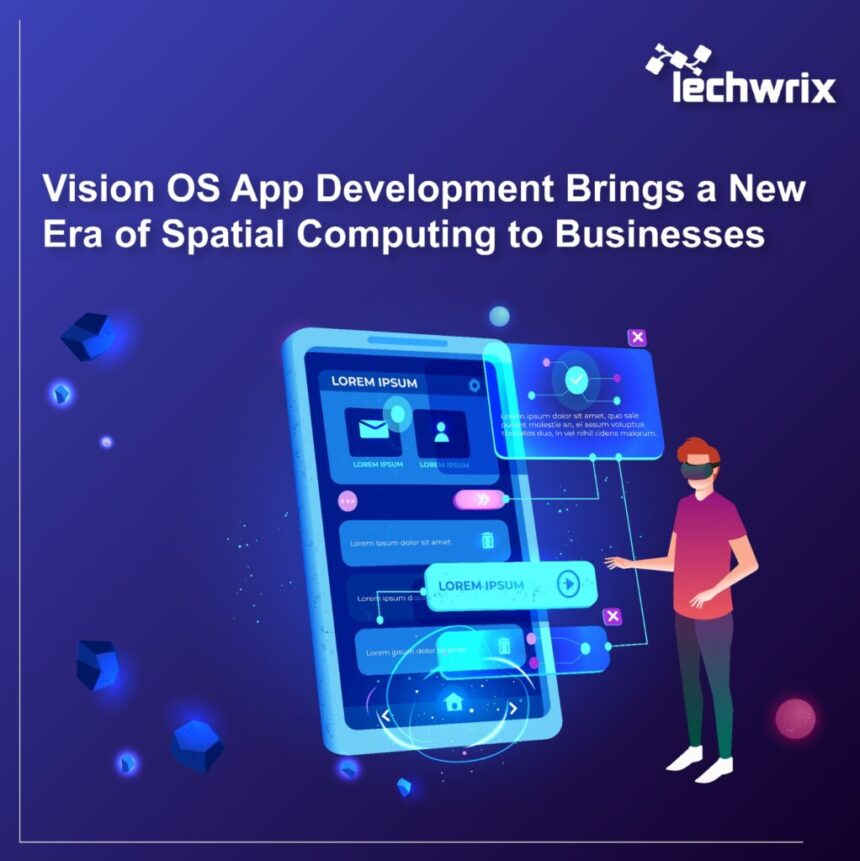For decades, Apple has worked to provide innovative products and services for businesses. Today, Apple products are used by all of the Fortune 500 companies in every industry around the world. Be it the launch of iPads, iPhones, MacBook’s, Apple watches or anything else, is preferred by employees when given the choice at work. Apple’s unique combination of hardware, software, services, and built-in support for IT makes it incredibly easy to manage and secure devices at scale.
With the introduction of VisionOS, the new operating system by Apple is grabbing attention by bringing augmented reality and virtual reality experiences to end users to grab experiences that previously were not possible. Imagine yourself in a workspace where digital elements seamlessly blend with the real world. Numerous windows arranged in closed proximity, but instead of limited to a computer screen they are presented in midair… WAO!!
So in this blog, we will understand how Vision OS can app development brings a new era of spatial computing to your business. In addition to exploring important aspects such as cost, complete development process, must have features and more. Stay tuned!
What is VisionOS?
A brand-new operating system called VisionOS was created especially for mixed reality. At the 2023 World Developers Conference (WDCC), alongside the Apple Vision Pro headset, Apple’s VisionOS is a spatial operating system tailored for the company’s AR/VR ecosystem. While sharing core architectural elements with MacOS and iOS, this OS marks a new chapter for Apple.
Neither a mouse nor a touchscreen are used to navigate VisionOS, unlike popular operating systems for laptops or phones. Rather, it combines vocal instructions with a combination of hand and eye tracking. With this, you can use finger motions to operate virtual items and apps just by glancing at them. VisionOS offers a futuristic interface similar to manipulating 3D things in front of you or moving windows around in a virtual realm.
Apple users will recognize VisionOS as it is based on the iOS platform. Interacting with real and virtual objects in a 3D space can now be done through voice commands, gestures, and more thanks to spatial computing.
The Role of VisionOS in Powering Spatial Computing for Businesses
VisionOS is the superhero that powers these incredible technologies. It equips businesses as a cutting-edge tool which boosts productivity and offers unique solutions.
Reaching a Broader Audience
With this new platform, businesses can create immersive training programs, interactive marketing campaigns, and innovative product demos that captivate customers and drive brand loyalty.
Staying Ahead in the Market
You can stay ahead of technological advancements, stand out in the market, and deliver unique experiences that leave a lasting impact on your target audience.
Enhanced User Engagement
You can create apps that offer either a partially or fully immersive experience. Games that engage the user in a virtual world, Apps that let users try on new outfits, media streaming applications that would allow the users to enjoy their desired shows on Apple’s Vision Pro, and more.
Boosting Productivity with VisionOS Integration
VisionOS creates immersive user experiences for a productivity boost. It blends the real world with the virtual, making work easier and faster.
VisionOS App Development Features
Spatial Awareness
Spatial awareness is the bedrock of VisionOS. Capture memories in a whole new dimension with Vision Pro’s spatial photo and video capabilities. Users can instantly record immersive spatial images and videos, complete with Spatial Audio integration, allowing them to revisit experiences in stunning 3D detail using pass-through cameras and LiDAR scanners. VisionOS application development facilitates the integration of these features into various apps, offering users unparalleled multimedia experiences.
Users can also surround themselves in sound that transcends traditional stereo. Integrate Spatial Audio with your app to create dynamic, three-dimensional sound effects that adapt to the user’s head movement. This can completely transform the user experience.
Accessibility
VisionOS caters to a wide audience. You can experience seamless multitasking with Vision Pro’s Infinite App Canvas feature. This innovative functionality allows users to launch and organize multiple floating app windows in their spatial environment, enhancing productivity and efficiency. Ensure your app supports accessibility features like voice control and eye tracking. This allows everyone to enjoy the unique capabilities of VisionOS, regardless of their abilities. Just imagine controlling your entire virtual workspace with voice commands, or using eye tracking to navigate complex menus.
Cutting-Edge 3D VisionOS
VisionOS throws away the rubric on flat displays. With RealityKit and SwiftUI, you can craft lifelike 3D objects that interact with the user’s surroundings. This opens doors for unparalleled user engagement.Think about a productivity app that lets you visualize tasks and projects in a 3D workspace, or a museum app that brings historical articles to life in your living room.
Dedicated Low Latency Chip
Powering the Vision Pro is a dedicated low-latency chip, ensuring optimal performance while conserving power. By leveraging the M2 Silicon chip and a new R1 chip, VisionOS app developers can create responsive applications that deliver unparalleled user experiences.
Eye and Hand Tracking
VisionOS offers innate control methods that go beyond traditional buttons and touchscreens. By designing your app to respond to natural eye gaze and hand gestures, you create a user-friendly experience that feels effortless. Now you can browse a virtual store where you simply look at an item to get more information, or navigating a complex 3D model by using hand gestures to rotate and zoom.
Step by Step Guide to VisionOS App Development Process
The journey of creating a groundbreaking VisionOS app starts with a spark of an idea and climaxes in a thriving user base. This guide will explain each stage of the development process, empowering you to bring your vision to life.
Conceptualization and Planning
In the early phase of VisionOS AR app development, the team engages with stakeholders to brainstorm and shape the app’s concept. This involves grasping the app’s goals, audience, and key features. Next, a comprehensive plan is created, delineating the app’s functionalities and user experience to offer precise guidance throughout the development journey.
Design Phase
In the design phase of visionOS app development, designers accurately craft the UI and UX of the AR application. The goal is to produce visually appealing and intuitive interfaces that elevate user engagement. Every detail, including AR elements and interactions, is thoughtfully designed to deliver a seamless and immersive experience for users.
Development Process
During the development stage, the AR app undergoes coding and implementation. Developers influence VisionOS technology to integrate AR functionalities and bring the defined features to life. This phase comprehends writing code, constructing the app’s architecture, and ensuring compatibility with VisionOS and other devices.
Testing and Debugging
A flawless launch is paramount. Testing is conducted to identify and rectify any errors or bugs, ensuring the VisionOS software runs smoothly. Several tests including functional, usability, and performance testing are performed to guarantee a stable and reliable app, delivering a superior user experience.
VisionOS Development Services – The Way Forward For Businesses
VisionOS development services offer businesses a comprehensive range of solutions. From developing utility apps to creating immersive games it tailors to harness the power of spatial computing. With the power of VisionOS and spatial computing benefits, from healthcare and education to gaming and real estate, the opportunities for building VisionOS applications are vast and varied.
Here are use cases across industries
Gaming
VisionOS application development significantly amplifies the gaming experience, providing gamers with lifelike experiences. VisionOS app developers can enhance mobile games with 3D models and AR/VR technologies, elevating the standard of gaming.
Media and Entertainment
The media and entertainment industry has seen a revolution with the advent of AR/VR technologies, and VisionOS app development plays a pivotal role in this change. Companies can offer their customers and viewers mesmerizing 3D experiences, improving user engagement and satisfaction.
Healthcare
Medical training simulations, aiding in diagnosis and treatment planning can be facilitated by VisionOS applications. This utilization of VisionOS app development enhances learning outcomes and elevates the overall quality of healthcare services.
Ecommerce
Ecommerce benefits immensely from VisionOS app development, enabling AR/VR experiences that allow customers to try products virtually before making a purchase. This innovation in online shopping is made possible through the superior features of VisionOS, enhancing the shopping experience.
Education
Education sector has been revolutionized through the use of AR/VR, and building VisionOS applications further enriches this transformation. VisionOS app developers can create audio-visual content tailored to specific subjects, improving interaction and communication between learners and teachers. This approach makes learning more engaging and memorable.
Automotive
VisionOS app development can enhance the features of smart vehicles, contributing to safety and enabling vehicles to communicate with users and other vehicles more effectively.
Tourism
VisionOS app developers can create virtual tours of landmarks, historical sites, and cultural attractions, allowing users to explore destinations in augmented reality. This innovation enhances travel planning and offers a preview of the experience before visiting in person.
FAQ
How can a VisionOS app benefit businesses?
A. VisionOS apps offer a secure and customizable platform to create innovative solutions for your needs. These apps can boost customer engagement, streamline internal processes, and provide valuable data insights to improve your business operations.
What types of apps can be developed for VisionOS?
A. Many types of apps can be developed. From customer-facing apps for loyalty programs or product catalogs to internal tools for inventory management or data analysis, VisionOS can accommodate a wide range of functionalities.
Do we need coding experience to develop a VisionOS app?
A. Not necessarily. The low-code/no-code development tools are available for VisionOS that allow businesses to create basic apps without extensive coding knowledge. But, for complex apps, partnering with a qualified VisionOS app developer is recommended.
How much does it cost to develop a VisionOS app?
A. The cost depends on the complexity of your app’s features, development time, and chosen development approach whether in-house or outsourced.
How long does it take to develop a VisionOS app?
A. The time it takes to develop an app depends on how intricate it is. Simple apps can come together quite quickly, while those with more features can take a lot longer to develop.

















